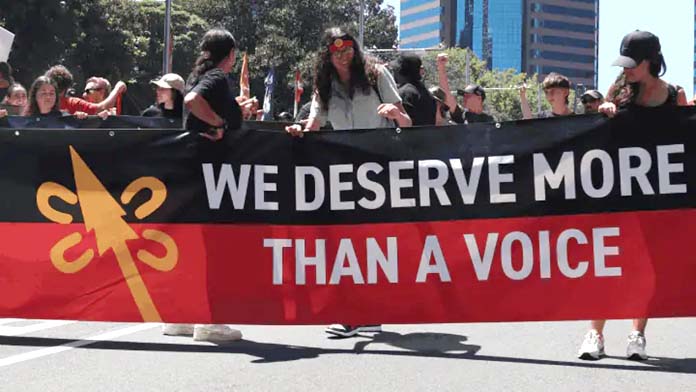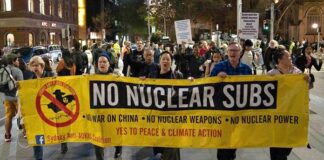Support for the referendum on the Voice to Parliament is still plummeting. Polling in the weeks after the date was announced showed an average of just 43 per cent will vote Yes.
A referendum requires not just an overall national majority vote but a majority in four out of six states to succeed. This has become a high bar for the Yes vote to clear.
The biggest problem is the Voice proposal itself. It was designed from the beginning to be acceptable to the Liberal Party, as a toothless advisory body that would be completely under the control of parliament.
As the Nine Papers’ Peter Hartcher put it in his defence of the Voice “there’s nothing so ordinary and innocuous as another advisory group.”
As right-wing opposition to the Voice grew, Albanese and the Yes campaign responded by emphasising how little the Voice would change.
Albanese has said any advice to change Australia Day from 26 January would be rejected. He says the Voice has “nothing to do” with a Treaty, despite supporters of the Voice arguing for years that it was a step towards one given the call for “Voice, Treaty, Truth” in the Uluru Statement.
Instead he says the Voice will focus on health, education, housing and employment.
But launching the campaign, Albanese even said the Voice would mean “that we save money” through ending wasteful spending—hosing down any idea there would be the funding increase needed for Indigenous communities.
This has undermined enthusiasm for the Voice, fuelled the significant Indigenous opposition and meant the campaign is unable to convince people it will make any real difference.
Albanese has also fed cynicism about the Voice by refusing to act on issues that matter to Indigenous people such as deaths in custody, child removals, or mining companies destroying Indigenous land.
The corporate branding of the Yes campaign has shown how distant the campaign is from the lives of Indigenous people. The bosses of Wesfarmers and BHP are on the board of the Yes campaign as are Liberal party stalwarts Tony Nutt and Mark Textor.
Albanese even wore a Rio Tinto shirt to a press conference to show his support for the mining companies.
Albanese has said nothing about the Queensland Labor government’s disgusting decision in late August to override its own Human Rights Act to allow Indigenous children as young as ten to be legally imprisoned in police watch houses.
Peter Dutton and the No campaign are doing everything they can to create division and encourage racism.
Some are already taking the falling support for the Voice as a sign that the problem is ordinary people. Aboriginal author Jackie Huggins has said that “This is a referendum on what people think of us.”
But the real blame lies with Albanese for running a tokenistic referendum that offers no power to Indigenous people. He is more interested in his government’s image than in real action on Indigenous rights.
The Yes campaign can’t build enthusiasm for a fight for Indigenous rights because the Voice isn’t offering any real rights.
Solidarity members will vote Yes. But whether the corporate Yes campaign or the racist No campaign wins, to challenge the institutional racism of the police, the courts and corporate Australia we will need to revive the protest movement and build the grassroots, united black and white struggle with the power to fight the system.
Labor’s right-wing agenda
Albanese has used the referendum to give the government a progressive fig leaf, but Labor’s deeply right-wing agenda is becoming harder to hide.
It was blatant war mongering at Labor’s National Conference in August, where Albanese forced through a vote in support of the $368 billion AUKUS nuclear submarines.
Albanese will do anything to prop up Australian corporate profits; happy to help protect Qantas and its $2.47 billion profits by refusing to allow extra Qatar Airway flights, but was silent about the 1700 workers illegally sacked by Qantas during the pandemic.
Meanwhile Employment minister Tony Burke is talking up the impact of the Closing the Loophole legislation for gig economy and labour hire workers. But, despite the noises from the Business Council, Labor’s legislation will still allow businesses to steal superannuation, pay less than the minimum wage to gig economy workers, and it won’t criminalise “accidental” wage theft.
Labor won’t act on the cost of living, or challenge corporate power, but workers can. Workers at Chevron’s offshore Gorgon and Wheatstone gas projects in WA have flexed their muscles, with the potential to hit Chevron’s multi-billion profits by cutting up to seven per cent of the world’s gas supplies.
University staff at Melbourne Uni, RMIT and other Victorian universities are continuing industrial action with claims for above inflation pay, and for secure jobs to cut casualisation.
It is strike action that can confront the bosses’ power and challenge Labor’s protection racket for corporate Australia head on. Whether it’s Aboriginal rights, climate or cost of living, building strikes, protests, and movements on the streets is what is needed to win real change.






